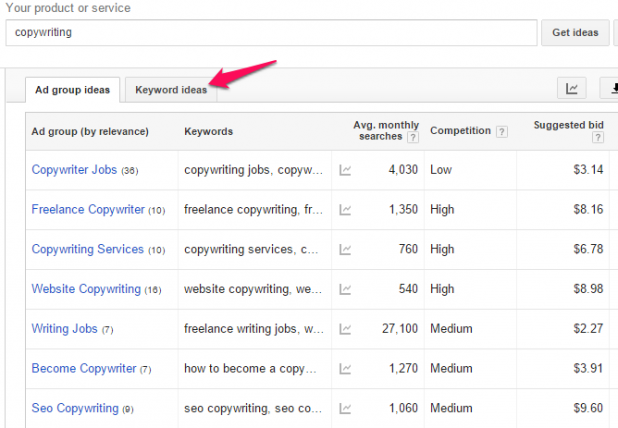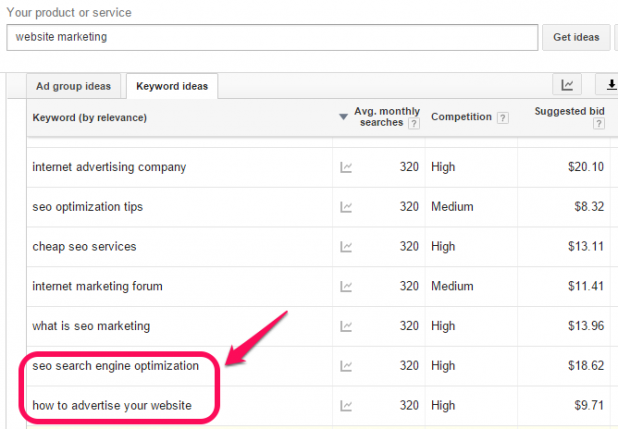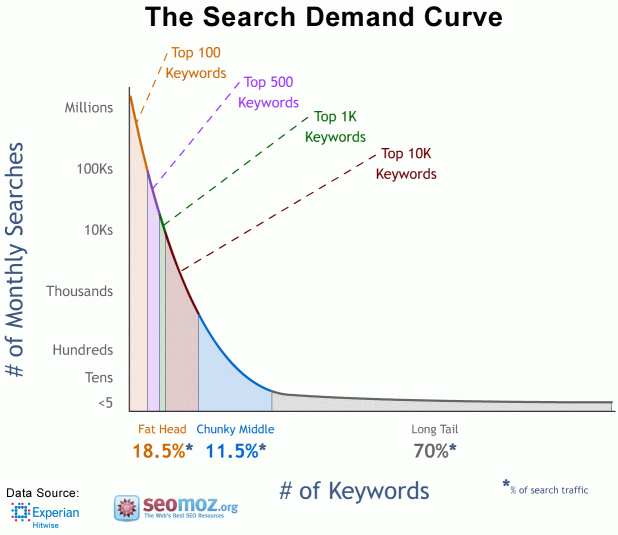As a business, establishing a better line of communication with active users on the internet requires optimizing your online content so that your webpage/website ranks higher in search results. Search engine optimization can do wonders by attracting potential users and increasing your conversion rate.
Identifying keywords most relevant to your business draws more focused, committed, and desirous customers. If you’re new to keyword research, long tail keywords are a good place to start because they are a reliable resource for generating more organic traffic to your product, services or articles.
Overview of long tail keywords
Long tail keywords refer to very, very specific search phrases that are relevant to what you’re selling, and consist of more than three words. They are much easier to rank for than head keywords, and even though they’re less likely to be used by a user in search, they ensure higher conversion rates for your service and product.
A customer using a specific search phrase denotes a high commercial intent, which means they’re looking for exactly what they’re actually going to buy. Long tail keywords are geared towards the kind of research a customer typically does right before making a buying decision.
For easy understanding, let’s consider that you’re selling shoes, and trying to drive traffic to your website. In this particular case, the head keyword ‘shoes’ will record over 621,000,000 pages on Google, and an average of 1,220,000 searches per month. That being said, it doesn’t tell you what the user is actually looking for – fancy flats, hiking boots, sneakers, pumps, or anything else that falls under the ‘generic’ category of ‘shoes’. However, a long-tail keyword like ‘red Nike running shoes’ has far fewer searches per month, and can bring you a steady flow of potential customers looking for exactly what they want.
To put things into further perspective, the top 10,000 head keywords account for only 18.5 percent of total search traffic, and you’d be missing out on 81.5 percent of organic visitors if you do not focus on long-tail keywords. Not only are they more profitable and easier to target, but integrating long tail keywords in your content strategy reduces significant competition and increases your organic traffic by almost 80 percent.
Amazon attributes 57 percent of their sales to long tail keywords, and another SaaS company discovered that in comparison to generic head keywords, long tail search terms performed 2.5 times better.
Long tail keywords can be further categorized as informational and commercial, with the former being targeted towards consumers who are yet to make up their mind about buying, and the latter focusing on consumers who are ready to make a purchase.
Commercial long tail keywords usually include a call-to-action as a prefix or suffix. For example, Spyware Doctor 4.0 review, Amazon Fire Stick discount, buy a Panasonic plasma TV, coupon weight loss program. Popular informational keywords include: how to lose weight workouts, make money on the internet for free, search optimization tips, top 10 free WordPress plugins.
How to research long tail keywords?
The easiest way of staying on top of keyword trends to ensure relevant content and refine search campaigns is by using Google Keyword Planner to discover new keywords pertaining to your business, compare keyword search volume, and create ad groups to bid on your preferred keywords. With a user-friendly interface, the Google Keyword Planner is available for free and can be used in the following ways to generate long-tail keywords:
Step 1: In order to find long-tail variations of a head keyword, use the Google Keyword Planner to get ideas. Let’s assume, your head keyword is ‘copywriting’, in which case go ahead and type ‘copywriting’ in Google Keyword Planner, and scroll below to click on ‘Get Ideas’.


Step 2: Under the ‘Keywords Ideas’ tab, you’ll find a list of relevant and in-demand keywords that you can later expand to get long-tail variations.

Step 3: Place your selected keywords into the search bar of the Google Keyword Planner to get long-tail keywords.

Step 4: Once you’ve gathered an ample number of long tail keyword ideas, carry out a quantitative and qualitative keyword competition analysis for keywords with the highest search results, to get a final list of 11-12 long tail keywords that you can use for on-page SEO optimization.
How to implement long tail keywords in your blog posts?
In a recent case study by Blogger, 60 percent of businesses don’t own a blog, while 65 percent of businesses haven’t posted new content on their blog in over a year. A regularly updated blog holds an enormous marketing potential, and can single-handedly increase the traffic and conversions on your website. An average person reads 5-10 blogs per day, and 31.1 percent of consumers find a brand’s blog to be the second most influential factor while making a purchase. Not only this, 70 percent of consumers learn about a brand through their blogs rather than ads, while 61 percent of consumers bought a product after reading a blog.
Having a blog also increases the number of indexed pages you have on your website by 434 percent, and your inbound links by 97 percent, guaranteeing a tremendous boost in organic search traffic. Here’s a quick guide on how to optimize your blog content, by incorporating long tail keywords relevant to your business:
- Use keywords in your blog title: While this is one of the best ways to incorporate a long-talk keyword in your titles, make sure you don’t compromise the ability of the title to attract readers and interfere with their motivation to read further.
- Focus on using only two to three keywords in your blog post: Using too many long tail keywords dilutes your content, and can make your blog post look like spam for both the search engine and the readers. Stick to a maximum of three keywords per post to maximize search traffic.
- Spread out your keywords: While you focus on using long tail keyword phrases multiple times through your blog post, it’s important to not stuff them together. For best results, use at least one long tail keyword in the first 200 words, several times in the paragraphs that follow, and in the concluding lines.
- Use keywords in and around the links in your post: If SEO experts are to be believed, Google places less weight on unlinked text than it does on linked text when deciding the search page ranking. Therefore, it’s highly recommended to use long tail keywords in and around the links you insert in your blog post.
- Insert keywords in image ALT tags: Whenever you upload an image in your blog post, you’re offered the option of entering an alternate text for that particular image, which will appear if your image doesn’t load. Since the alternate text is part of the HTML in your blog post, content as the ALT tag, Google, and other popular search engines tend to crawl ALT tags for providing keyword search results.
Other Keyword Research tools
Having a clear idea of what direction you want to take your brand in the future, and how you want to shape your content can greatly affect your website development process. If you’re in the process of updating your website to be more SEO optimized, spending time doing keyword research to help guide your overall content strategy is of paramount importance. There are several keyword research tools apart from Google Keyword Planner that you can check out to see what you like the best. Here’s a quick list:
Google Correlate:
As a frequently overlooked tool, Google Correlate is considered to be extremely powerful when you need help in generating a large list of keywords. If you’re stuck in a keyword rut and have exhausted all your keyword suggestions, then Correlate offers you a great means of escape. Simply enter your primary keyword in the search bar to get a list of all the related keywords that appear in the search results together.

IMforSMB Bulk Keyword Generator:
A lot of keyword research tools work well only for certain types of website, and if your website doesn’t fit the bill, then IMforSMB Bulk Keyword Generator can be a great help. Designed specifically for local service companies, IMforSMB Bulk Keyword Generator finds local keywords based on your business type and service location.
Step 1 : Choose Business Type:

Step 2: Choose your service type:

Step 3: Enter your service location and voilà!

Soovle:
Available for free, Soovle provides uses a variety of sources to compile a list of autocomplete suggestions to boost your search volume. What sets Soovle apart is that it takes sources like Yahoo, Amazon, Bing, Wikipedia and Youtube into account, while generating keyword suggestions from each source.
Step 1: Choose your source by clicking on one of the several icons below the search box.

Please note that the keyword suggestions offered by Soovle aren’t the most advanced, but you can always find a few good ones. The best way to utilize the tool to your advantage is by experimenting with multiple keywords and paying close attention to the results obtained from each source.
Here’s an example if you’re looking for keywords related to ‘digital marketing agency in delhi’

UberSuggest:
If you rely heavily on Google Keyword Planner, it is important you remember that you don’t always get as much data as you might expect. This is where UberSuggest comes in, providing you an alphabetically arranged list of keyword suggestions that the Google Keyword Planner missed out on.

You can always run UberSuggest, once you’re done with Google Keyword Planner to stay more organized and comprehensive in your approach.
Keyword In:
If you’re looking for an easy way to combine your keywords, then Keyword In is the right choice. Start with a primary head keyword, or a long tail keyword, and watch as this simple yet effective tool mashes everything up to give you a lengthy list of potential keywords that you didn’t think of before. Here’s how it works:

Keyword In takes only a few seconds to plug, choose and generate relevant keywords for your business.

Conclusion
Using long tail keywords in your marketing campaigns makes for a win-win strategy, where you get better search rankings, lowers costs per click, and more qualified search traffic. As an online business, bidding on long tail keywords not only ranks you higher in Google search results but also provides valuable insights to advertisers looking to run paid search marketing campaigns.
With smart implementation, long tail keywords ensure a higher return of investment (ROI), attract exactly the kind of audience you want to target, and give you a head start to stay ahead of your competitors.






